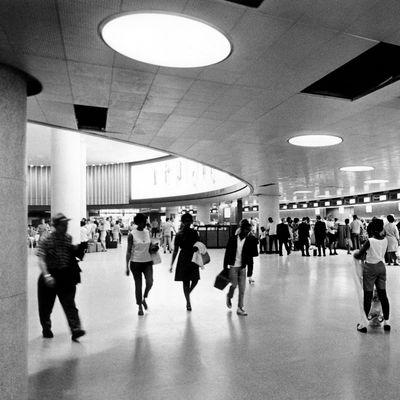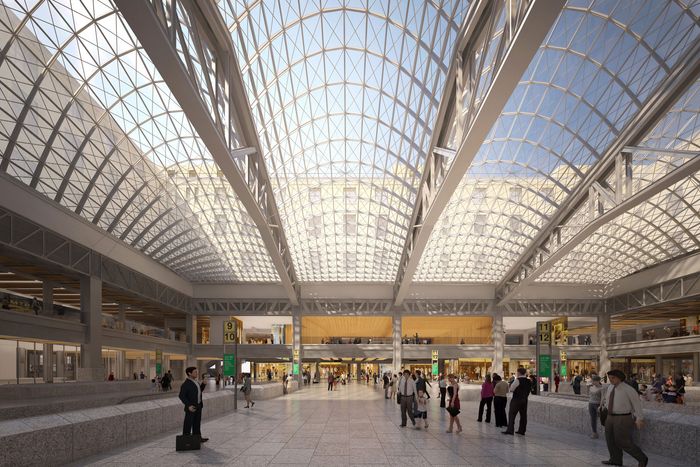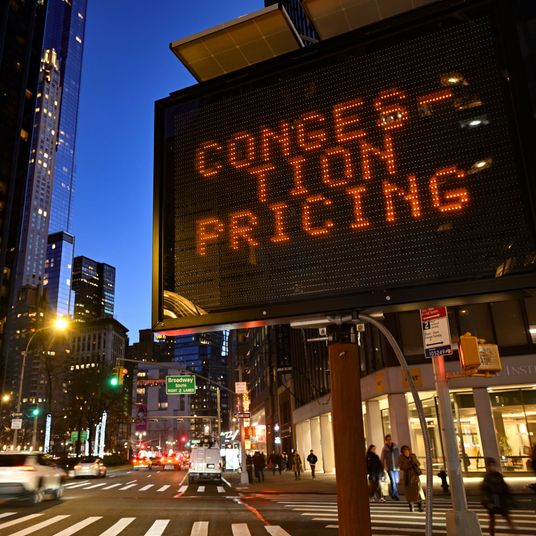
Penn Station’s current woes would have surprised transportation experts in the 1960s, when the old one was razed. At that time, rail looked like a dying technology. Ridership had dwindled, and Penn Central Railroad was running out of cash. One of the juiciest assets in its withering portfolio was the station itself, or, to be precise, the air above it. When they tore down McKim, Mead & White’s structure, a gracious and light-filled but financially useless temple to travel, developers put up a cash cow in the form of a sports arena and a group of office towers.
All these decades later, even a neglected and shoddy rail system remains the cheapest, most efficient, and (sometimes) fastest way to travel between Manhattan and the suburbs, or even (depending on weather and time of day) between New York and cities on the Eastern Seaboard. Penn Station, optimistically built to handle 200,000 passengers a day, now has to contend with more than triple that number. The result is that huddled masses begin and end their workdays like livestock, penned into inhumane sheds, funneled along claustrophobic chutes, and packed into slow-moving cattle cars.
Fixing Penn has been a fond dream for decades, but each attempt has foundered on the shoals of inertia, conflicting agendas, and shortsightedness. A bad train station’s problems are dauntingly complex and intertwined. What’s the point of a nice new transit hall if passengers are still crammed on narrow platforms with tight exits? What’s the point of increasing the station’s capacity if trains still have to inch through crumbling tunnels under the Hudson, hoping they stay intact for one more run? And even if the president of the United States didn’t have a personal animus for his hometown and was inclined to support construction of a new rail tunnel, called Gateway, the rest of the eastern corridor would still be laughably out of date. High-speed rail remains an Obama-era chimera. Given all that, the catalogue of plans has seesawed between thinking big and making do. Some planners insist that passengers deserve more uplifting architecture, even if the guts of the system are rotting. Others hold that building a new Penn Station without addressing the deeper dysfunction is like fitting out your house with gold-plated faucets but forgetting to replace cracked pipes.
Here, then, are a baker’s dozen plans, spanning four decades, organized from worst to better. “Best” is still out of reach.
13. LIRR (1988)
The big idea: Two decades after it opened, Penn Station was already such an embarrassment that the Long Island Rail Road decided to confront the facility’s deep-seated troubles with a bout of cosmetic surgery: new lights, screens, signs, speakers, and finishes.
Did it work? A $73 million (and, eventually, more) project intended to “transform the bleak, poorly lighted, often chaotic recesses of the station into a bright, inviting and efficient port” (as the Times optimistically put it) resulted in years of construction misery, air conditioning, and some imperceptible other improvements.
12. Penn Central (2020)
The big idea: Adrian Untermyer, a preservationist, urbanist, keyboard player, and now University of Colorado law student, believes in the transformative power of tinkering. A few years ago, he got attention for his unlikely feat of momentarily beautifying Port Authority Bus Station with live piano music. Recently, he issued a manifesto that puts a piano at the center of a Penn Station overhaul: live music accompanying a procession made miraculously sane by separating entrances from exits.
Will it work? Untermyer calculates that his plan, which involves scrubbing and painting the existing architecture, rerouting passenger flow, and rigging up wider platforms by rolling flatbed rail cars onto the tracks, could be wrapped up in no time by closing Penn Station down one sleepy August and rerouting commuters for a hellish month. It’s a masterpiece of urbanism by rubber band and wishful thinking.
11. Rebuild Penn Station (2016)
The big idea: Re-creating McKim, Mead & White’s granite-and-crystal palace is right up there with rebottling genies and uninventing the internet as a practical plan for the city’s future.
Will it work? Sure, it would be nice to right a historical wrong, though in a world where skilled stonemasons are in short supply and cost a lot more than in 1910, this leap into the past would probably require a bottomless well of money and time. It’s also a purely aesthetic answer to a tangle of concrete logistical problems. Among them is the main reason for the station’s crowding: Three times as many passengers as the original was designed to handle trundle through every day.
10. Olympia & York (1987)
The big idea: It was clear almost as soon as it opened that Madison Square Garden, plunked atop Penn Station like an elephant on a chipmunk burrow, had condemned commuters to scurry in the gloom. Getting rid of it seemed both necessary and impossible. The Canadian firm Olympia & York suggested banishing it to the island’s western edge, between 11th and 12th Avenues at 33rd Street, so that it would sit over railyards instead of a station. This wasn’t so much a civic-minded public-transit proposal as a real-estate gambit, since the move would open up a new skyscraper district around and above Penn.
Would it have worked? One problem was that suburban sports fans, instead of streaming right upstairs from NJ Transit and LIRR platforms, would have a 20-minute walk through some of the bleakest blocks in Manhattan to get to the game. It’s a good thing the deal never went through, because the company went out of business five years later, leaving tens of billions of dollars of debt.
9. Moynihan Station No. 1 (1993)
The big idea: The first breakthrough in the attempt to restore some dignity to the commute came in 1993, when Senator Daniel Patrick Moynihan persuaded President Bill Clinton to convert the Farley Post Office Building, across Eighth Avenue from Penn Station, into a new train hall for Amtrak. There was a satisfying symmetry to that idea: While Penn Station grew more and more congested, Farley had all but emptied out. Mail no longer arrived by train or converged on a central location, so the Postal Service didn’t need its huge skylit sorting rooms. And McKim, Mead & White, the firm that designed the late lamented first Penn Station, also designed the post office. The architecture firm Hellmuth, Obata & Kassabaum (subsequently renamed HOK) rushed in with a design for a lofty glass vault that would evoke the lost glory.
Why didn’t it work? At first, it seemed like a visionary idea, neatly recycling a Beaux-Arts landmark as an homage to its lost cousin. In retrospect, though, it had some lethal flaws. The support of two Democratic senators from New York and a lightning-rod Democratic president made it easy prey for the Republicans who swept into Congress in 1994. It also became clear that Amtrak’s glass cathedral would rise too high, cost too much, and do nothing for the vast majority of Penn Station’s users, who use LIRR, NJ Transit, and the subway. “To the architect charged with creating the new Penn Station’s symbolic center, lots of luck,” wrote the critic Ada Louise Huxtable; “he has a long way to go.”
8. Vornado (2000–present)
The big idea? As the efforts to convert the Farley Post Office to Moynihan Station sputtered and flared over the years, the real-estate developer Vornado, which controls much of the land around the building, expanded the plan’s ambitions to overhaul the entire area. In one $14 billion swoop, Madison Square Garden would move a block west to the Farley’s annex on Ninth Avenue, and the district would sprout a bouquet of new supertall office towers.
Why didn’t it work? The plan looked good on paper, but it was booby-trapped with nonstarters. Among them was an insuperable paradox: Adapting the 1912 Farley Post Office could free up nearly a quarter-billion dollars in federal historic-preservation tax credits; demolishing the annex to make way for the Garden would make those funds disappear. In 2008, the project was hit with a triple whammy of misfortunes: Estimated costs multiplied; Governor Eliot Spitzer, one of its chief supporters, quit in disgrace; and the financial crisis definitively killed it off. But Vornado’s still hoping a refurbished Penn Station yields a real-estate windfall, and a few months ago it floated the idea of luring Facebook by demolishing the Hotel Pennsylvania and replacing it with a 1,400-foot office tower designed by Rafael Viñoly, a kind of hanging gardens of Midtown South.
7. Penn 2023 (2013)
The big idea: The Dolan family, which owns the Garden, has evinced no desire to move it, and even poured $1 billion into a top-to-bottom renovation. Still, the arena operates by special permit from the city, and in 2013, the City Council extended that dispensation by just ten years, effectively handing down a moving date. Even before the vote, the Municipal Art Society commissioned a handful of architects to imagine a Garden-free Penn Station, or even a completely rearranged West Side. SHoP revived the idea of installing it on the waterfront at Hudson Yards, an almost sensible idea given the massive development that was already in the works there. Diller Scofidio + Renfro reimagined a train station as variations on the theme of waiting, so that hurried passengers can grab a quick espresso at platform level, and those with more time can drift up a few floors to take a nap or spend an hour at the spa.
Would it have worked? The speculative project didn’t have to deal with pesky realities, like how many billions it would cost to realize, or how hockey fans would move en masse to a rink with skeletal public transit. And if 2023 rolls around and the Garden’s still there, the Council may have no choice but to simply give it a further, and perhaps indefinite, extension.
6. Penn-Farley Relaunch (2016)
The big idea: Casting himself as the infrastructure closer, Governor Andrew Cuomo announced four years ago that Moynihan Station was finally chugging toward reality. The plan was a compendium of familiar ideas, reformulated into a fresh-looking package. Amtrak would share the new space with LIRR, and a set of new hallways and entrances would try to nudge the heart of the complex toward the emerging neighborhoods west of Eighth Avenue. The Moynihan design has evolved over the years, passing back and forth between architectural firms, each time becoming less exciting and more pragmatic. Back in the mid-1990s, HOK planned to crown the post office’s central court with an immense glass barrel vault. In 1999, Skidmore, Owings & Merrill shifted the center of flamboyance over to a mid-block passageway between the main building and the annex, where they envisioned a steel-and-glass canopy curling above the roofline like a wave. HOK (along with James Carpenter Design Associates) revisited the project in 2005 and doubled down on the idea of covering the central court with skylights, this time in the form of a wavy, woozy roof supported by reedlike columns.
SOM has since redesigned the project two more times, and the final iteration — which opens later this year — reaches for a modest kind of grandeur. Instead of placing the court under a giant bubble, the design reuses the original trusses to support a new set of glass vaults that arc across the opening like jets of water. The space beneath it will be expansive — almost as big as Grand Central Terminal’s main concourse — but with only a muffled echo of the original station’s imperial majesty. The blowback from the billions spent on Santiago Calatrava’s World Trade Center Oculus has jolted the state into architectural prudence. On the other hand, it seems you can never have too many indoor malls or tech campuses: The Farley Annex will be enlivened by shopping below, offices above.
Will it work? The core troubles remain. If you spend a miserable and unpredictable hour (or three) traveling between your home in the suburbs to your workplace in midtown, the new train hall will do nothing to improve your life.
5. ReThinkNYC (2017)
The big idea: The various Moynihan designs bring light in from above, but they don’t do much to alleviate the hellish belowground tracks, tunnels, platforms, and staircases that cause so much danger and delay. The firm ReThink Studio ties Penn’s woes to the fragmentation of the different rail systems run by NJ Transit and the LIRR, which converge on the region’s most congested spot from opposite directions. Then some empty trains shuttle off to different yards to wait for the evening rush, as others turn around and head back where they came from. The result is about as rational as having several interstate highways dead-end in a back alley. It takes so long to empty one train that it makes the next one late. ReThink’s solution is to abolish the terminus and convert Penn to a through station — just one stop on trains that plow back and forth between New Jersey and Queens.
Would it work? One catch is that it depends on a new rail tunnel beneath the Hudson River — the accursed, long-delayed Gateway project that Chris Christie scratched and President Trump has indefinitely suspended.
4. Fourth Regional Plan (2017)
The big idea: The Regional Plan Association, which specializes in we’re-all-in-this-together solutions, sees Penn as a node in a dysfunctional network that stretches across three states and three bureaucracies — NJ Transit, Metro North, and LIRR — that barely communicate. The RPA’s answer is a logical — which is to say, utopian — bundle of recommendations: Merge the different agencies into a single commuter rail system; build Gateway, and feed the extra capacity through Penn South, a new wing between 30th and 31st Streets.
Would it work? The fact that this list is self-evident and overdue doesn’t make it any more achievable. The Penn Station saga is a story of generational denial. New York is the patient who, told his respiratory system is shot, decides to maybe get a new haircut — eventually.
3. Penn Palimpsest (2016)
The big idea: The 8 gazillion-ton gorilla in the Penn discussion is Madison Square Garden. Could it move, would it move, and, if so, where? And if it did, wouldn’t that mean replacing it with an unaffordable architectural extravaganza just so passengers could experience a few extra minutes of pleasantness on their way to the street? Three years ago, Practice for Architecture and Urbanism (PAU), founded by Vishaan Chakrabarti, revived the idea of shunting it 800 feet west to the Farley Annex. More crucially, the firm came up with a way to open the station to daylight by upcycling the Garden’s steel skeleton as a superstructure for a cylindrical glass-topped station. Removing hundreds of the columns that now hold up the Garden’s concrete barrel would make the platforms more spacious. The design also preserves some of the history and materials of a venue that, for all its civic faults, thousands of sports and music fans adore.
Would it work? The beauty of the plan is that it could plug right into all the other variations, including Gateway and Penn South, but would also be a radical improvement without them.
2. Empire Station Complex (2020)
The big idea: Four years after bringing the Moynihan Station project back from the dead, and months before it finally opens, Governor Cuomo ratcheted up his ambitions for the area again. At last he’s recognized that a new pavilion doesn’t make the trains run on time, and he’s embraced the old idea of a Penn South expansion: a new terminal plus eight new tracks. The state has the power of eminent domain, which means Cuomo can persuade — and, if necessary, force — property owners to turn over an entire block for the new wing. Once Penn South is up and running, the existing station can be renovated, and the state has already hired the architecture firm FX Collaborative to produce the master plan.
As expansive as it is, will it work? Cuomo’s new grand strategy offers a menu of fixes that fall under the governor’s jurisdiction and seem achievable in a matter of years rather than generations. He can’t make Gateway happen without federal funds or conjure a seamless tristate common commuter rail system, or boost the chances of true high-speed rail ever making it to the Northeast Corridor. Cuomo also can’t (and his plan doesn’t) force the Garden to relinquish its perch, though it leaves open the possibility of demolishing the MSG Theater to create a new Eighth Avenue entrance. The plan’s real innovation is to turbocharge transportation policy with real-estate development, putting the project financially within reach. Transit improvements raise property values, and through a process known as value capture, the state can use the anticipated taxes to help pay for a better Penn.
1. Cuomo + PAU combo (2020)
The big idea: Cuomo insists that Penn can become a world-class transit hub even if it stays in Madison Square Garden’s basement. But even a thorough overhaul of the station’s core would still leave low ceilings, tight platforms, and no natural light. The options for moving the Garden westward have narrowed as the area has been built up: Hudson Yards, an expanded Javits Center, and tech companies eager for office space have mooted several locations. But Cuomo’s latest plan does leave one intriguing option on the table: the outlines of the Empire Station Complex’s “development district” extends eastward, all the way to Sixth Avenue. Chakrabarti points out that moving Madison Square Garden to a two-block site on the east side of Seventh Avenue, between 32rd and 34th Streets, would make it even more central. That would mean razing a collection of mostly undistinguished buildings, including the Old Navy, Hotel Pennsylvania, and the Manhattan Mall, and connecting the arena to Penn via a disused tunnel known as the Gimbels Passage.
Will it work? Penn Station is an old machine, so creaky, intricate, and jerry-built that at any attempt to replace one gasket triggers a fresh round of troubles. We have plenty of plans and an even greater abundance of reasons not to carry them out. You can’t just scrap the whole thing and start again, and halting operations for even a week would be a near catastrophe. The conditions needed to teleport the Garden to a new location, bore another Hudson tunnel, lay new tracks, erect a glorious station or three, and streamline the city’s archaic transit bureaucracies will never click into perfect alignment. But, like a train that’s been idling for hours in the New Jersey marshes, within sight of the Empire State Building, and then groans into motion, we may finally be on our way.













































